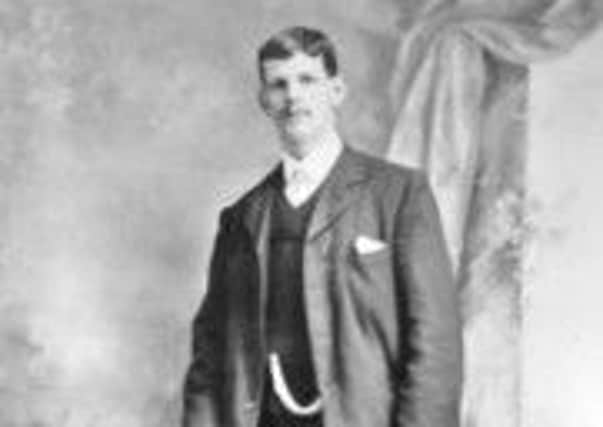Remembering one of World War One’s ‘clay-kickers’


Pat Galvin is now 79 and has spent many years researching her grandfather, F N R Miles, who died in one of the notorious tunnels dug by the Allies to sabotage the German’s trenches.
But, as people now know through books such as Sebastian Faulk’s ‘Birdsong’ and ‘Beneath Flanders Fields’ by Peter Barton at al, the Germans were also digging tunnels for their own attacks.
Advertisement
Hide AdAdvertisement
Hide AdIt was during one of these early attacks that Francis Norman Richard Miles, known as Richard, of Junction Road, Burgess Hill, perished on April 24, 1915, aged 35.
Sgt Miles, who was a mining engineer by profession and whose first wife had died in 1911, left three young daughters and a step-daughter, including Pat’s mother, Eva Anna, who was just 10 at the time.
Pat said: “Unearthing this history has taken years, mainly because we didn’t have his correct name – Francis was never mentioned, Norman was thought to be his second Christian name, which was why in the 90s I had been searching for a Richard Miles, which kept drawing blanks.”
Sgt Miles has no known grave but is commemorated at the Le Touret Memorial in France and in Burgess Hill on the town war memorial, the war memorial board at St John’s Church and St Andrew’s Church in Junction Road, and, formerly, on the memorial board at the old London Road School.
Advertisement
Hide AdAdvertisement
Hide AdPat, who now lives in Tadley in Hampshire, has given a talk to the Tadley Local History Group about her grandfather and would still like to make contact with the Burgess Hill branch of the Royal British Legion and the Burgess Hill History Society as part of her research.
But what she says is most upsetting is that, as far as she knows, none of Sgt Miles’ three daughters or step-daughter knew of his tunnelling work, although they were made aware of his bravery briefly after his death.
Pat said: “My mother didn’t know her father was a tunneller and it’s my sadness that I never thought about doing something about it until I retired myself.”
Sgt Miles was a member of the 170th Tunnelling Company of the Royal Engineers. The 170th was one of the inaugural companies formed by Major Jack Norton-Griffiths, who was an civil engineer by trade and an MP recruited by the government after the Germans’ initial, devastating tunnelling salvo that detonated multiple explosions and killed an entire company of 800 Commonwealth soldiers.
Advertisement
Hide AdAdvertisement
Hide AdSoon afterwards, at the start of 1915, Major Norton-Griffiths introduced to the military hierarchy the ‘clay-kicking’ technique for excavating the tunnels and, under his inspiration, the tunnelling companies, known as the Moles, later wrought their own terror on the German army.
Sadly, it was in the early days of these military manoeuvres that Sgt Miles, who lived in Junction Road, Burgess Hill, was killed.
According to documents produced by the librarian at the RE Museum, Chatham and other books she showed Pat, Sgt Miles was Major Norton-Griffiths’ foreman in civilian life as well as in uniform and died with his fellow ‘moles’, in the forefront of the campaign.
Pat said: “It seems that the Germans were in the next tunnel, there was a massive explosion and all our soldiers, including my grandfather, were killed.
Advertisement
Hide AdAdvertisement
Hide Ad“Whether they were killed by their own explosion accidentally being set off or whether the Germans set one off, we don’t know.”
At some point later, Pat’s mother and her three sisters, who were living with Sgt Miles’ second wife, Jenny, in Junction Road, had to prepare for a visit from Major Norton-Griffiths, who had become known as ‘Empire Jack’.
She said: “After the war, my mother could remember the girls being scrubbed up because Major Norton-Griffiths was visiting Valebridge Cottage, where my grandfather’s parents lived. She remembered the gentleman and lady sitting the girls down and him telling them ‘I want you to remember that he was not just my foremen but my friend’.
Pat still has four photographs of her mother and her aunts when they were children, in frames that were inscribed with the war dates of 1914-1918 and which she believes were given to war orphans.
Advertisement
Hide AdAdvertisement
Hide AdPat said: “I feel very proud of my grandfather and it is so poignant that his daughters all spoke about him as a lovely dad.
“His story is fascinating and deep.”
Pat says her step-grandmother, Jenny Miles, was president of the Burgess Hill Royal British Legion for many years.
“After his first wife Eliza died he had to leave the girls with relatives as his work took him to different places and it was whilst working on the Manchester sewers that he lodged with Jenny’s parents,” she said.
“She had an illegitimate daughter and because of the war situation it was arranged that they marry and she would come south to Burgess Hill to be near his parents, at Valebridge Cottage, Wivelsfield.
Advertisement
Hide AdAdvertisement
Hide Ad“In return he adopted Jenny’s daughter, Phyllis and gave her his name. As far as I am aware they had all lived in the same house, I think it was 236 Junction Road, opposite St Andrew’s church.
“During WW2 at different, and sometimes the same, times when we were all bombed out, we lived there and I went to Junction Road school. Nana, Jenny, and aunt Phyllis were involved with church work as well as the RBL.”
If anyone would like to contact Pat with further information about her grandfather, she can be contacted on 0118 981 3995 or by email at [email protected]